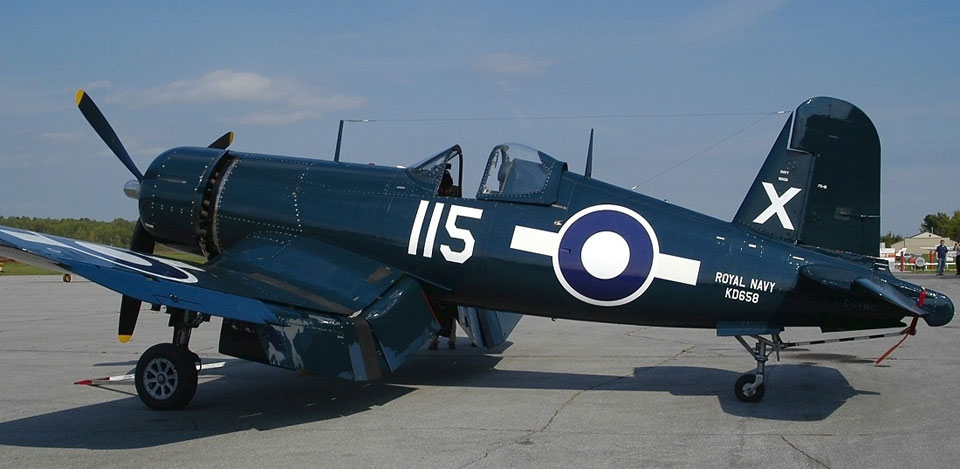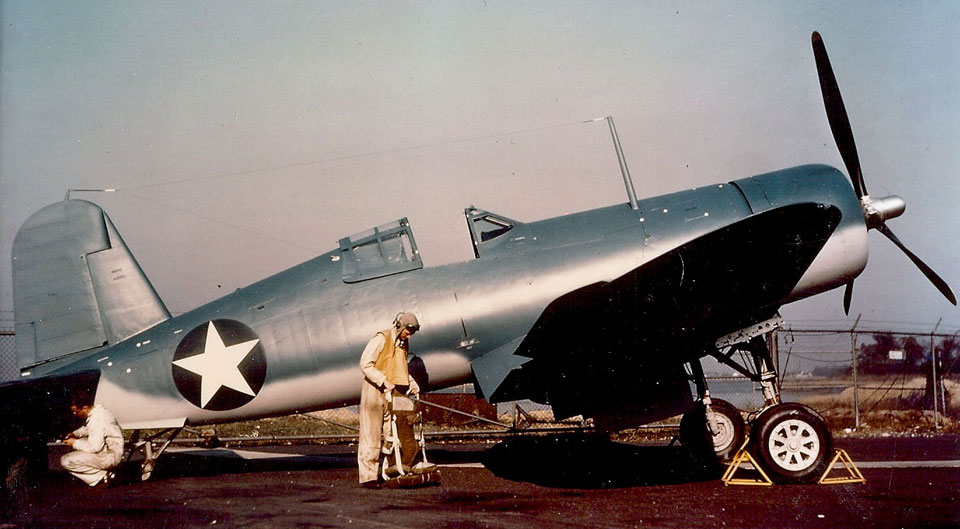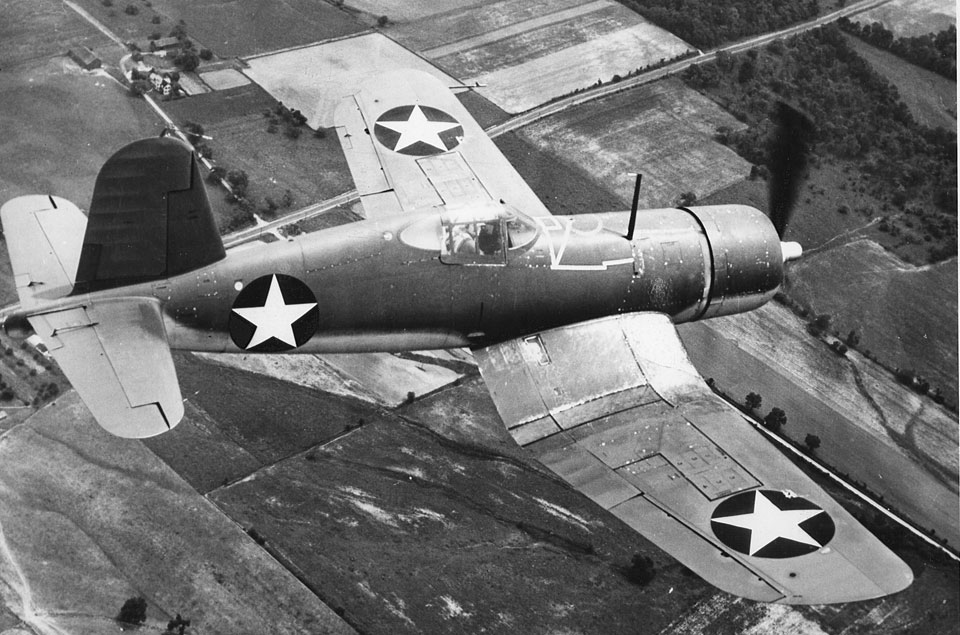Warbird Market Report: The Corsair
By Joseph Scheil, Editor - Briefing, EAA Warbirds of America 597792
April 2015 - Adding to the market report of last month, we look at the rare and heavily sought-after F4U/FG-1 Corsair. The iconic Corsair emerged as winner of AOPA’s recent “Best Aircraft Showdown” over a Piper Cub earlier this year. What AOPA means through this odd “Facebook likes” contest is unclear, as a Piper Cub cannot be beaten by any aircraft as far as I’m concerned, and the Corsair is not in the same ballpark.
In my view, the Cub is a foundation aircraft that teaches skills essential to moving up in performance. The Corsair is an apex aircraft, and if you don’t have the skills to fly it, it will kill you. However, should owners of those blue bent wing birds desire to trade up for my Cub, it would depend on the day and mission, I suppose, for which way I would go; after all, my wings don’t fold…and that does look cool.
Let us look at the Corsair as a civilian buyer should. First, 12,571 were made, in seven different variants, from 1942-1953. That’s a long production run – the longest U.S. piston fighter production run ever.
The World War II “Black Sheep” Squadron’s Corsairs were Dash Ones (though the TV show with Bob Conrad as Pappy had Ones, Fours, and Sevens!). This is the only true combat vet of WWII aircraft, though early Dash Fours made it to Okinawa at war’s end. We don’t really have any definitive combat records “proven” of the survivors, just assignment lists and certain aircraft to the Pacific, notably the Paul Allen/Warbird Heritage Collection aircraft. Both Vought and Goodyear aircraft were deployed to the Pacific with the U.S. Navy and Marine Corps, though only the rare F4U-2 saw carrier use as an interim night fighter. All other WWII Corsairs were land-based. Almost all of the early Corsair airframes deployed did not survive the war. We have a couple that were sent overseas, but no records of air victories or even operations for these survivors.
The Corsair was built in three plants during the war, initially by Vought-Sikorsky in the plant at Stratford, Connecticut. Goodyear Tire & Rubber in Akron, Ohio, was granted license production and finished building its first Corsair, an FG-1, in February 1943. It was completing 200 aircraft a month by 1944. Goodyear FG-1D production ended September 6, 1945, after 4,107 airframes.
In 1942 the Brewster Car and Aircraft Company of Long Island City, New York, was in serious financial trouble and was seized by the U.S. Navy on April 18 that year. Shortly thereafter the Navy assigned Corsair production to Brewster, which began completing F3A-1 Corsairs.
Production difficulties and several crashes contributed to the U.S. Navy refusing to send Brewster-built Corsairs to combat, and production was canceled on July 1, 1944. The company was shut down shortly after.
Restoration and Projects
Today there are approximately 45 Dash One survivors as there are a couple of “in the dark” projects that are similarly extant. Of the 45, at least 20 are known projects, and a Corsair is nothing close to a P-51 in terms of restoration complexity and difficulty. The spar and structure of the Corsair is super robust, and to this day it can only be duplicated with new material at an incredible cost, although some effort has been made to re-spar and rebuild Corsair airframes. It’s very expensive, and the rumor is a Corsair in parts may take a good shop between 20,000 and 40,000 hours to complete a project that has issues.
Seven of the 45 are government owned, so that leaves perhaps 17 marketable civilian Dash Ones. Most survivors are late-build Goodyear FG-1D Corsairs, nine of the 45 are Vought built, and one project is a Brewster F3A-1.
The Navy claims title to any wrecked or “lost” Corsair, so the chances of recovery and restoration of any extant Corsair wreck is remote. Notably there are two Corsair I (Vought-built Corsair for the Royal Navy) wrecks in amazing condition at the bottom of Sebago Lake, Maine – classified as war graves from which there would be excellent candidates for restoration.
The one that was in Lake Michigan has been recovered, and restoration (for display) continues at Naval Air Station Pensacola. But it’s owned by the Navy. The few fragmentary South Pacific wrecks that have been recovered are “survivors” but will not return to the air anytime soon, if ever. That makes a Dash One about 10 times more rare as a Mustang.
Corsair projects occasionally are available, like the one just listed and sold by Courtesy Aircraft, and while the initial buy may have looked achievable, restoration cost is estimated to be close to $5 million.
For a buyer today, there is no appreciable difference in builders of the plane as to value, as restoration and condition would probably be more relevant. However, history of the airframe can add great value to a Corsair, and a documented combat history can make a desirable aircraft truly special. While very few Dash One Corsairs have combat deployments to the Pacific, a high percentage of the later Corsairs do – to Korea. The Dash Four and Five Corsairs are better performing and have impressive history.
The only U.S. Navy ace of the Korean War, Guy Bordelon, flew F4U-5N, Bu. No. 124453, for all five of his kills, and while assigned to VC-3 aboard the USS Princeton, was detached to airstrip K-6 for night air defense duties with his Corsair.
While 124453 did not survive the war, many of the Dash Four and Five Corsairs existing today claim some Korean service. As collectors begin to pay deeper attention to the history of each individual surviving airframe, the values of the aircraft concerned will begin to separate based on a flexible (and subjective) matrix of originality, utility to the owner, documented history, and condition.
By the Numbers: Dash One’s…
Vought-Sikorsky Corsairs: 10 Survivors
The one flying example is at the Planes of Fame Air Museum at Chino, California. An ex-flyer is in a Brazilian museum, and two are in museums – the National Air and Space Museum and Fleet Air Arm museum in Yeovilton, England. There are currently four projects stored under restoration. Plus the two ex-Royal Navy planes at the bottom of Sebago Lake, Maine, but they are classified as war graves and are “hands off.” So there six civilian-owned, genuine Vought-built F4U-1 Corsairs worldwide. One has not come up for sale in a while!
Brewster F3A-1: 1 survivor
Recovered from a wartime crash site, this F3A-1 is a survivor that is well on its way to flying condition. Currently in Texas at Ezell Aviation’s Warbird Rebuilders, this long-lost and sole remaining example of Brewster production will be a showcase example of the Corsair line. It is the only one known and privately owned.
Goodyear FG-1, FG-1A, FG-1D: 36 survivors
There are 15 airworthy or flying FG-1 airframes, and another 10 to 12 projects out there in various stages of completion and viability. Some projects will probably be combined to create a “flyer” over time.
In most cases, wing spar damage or center section damage has kept these projects on the ground. There are two static projects currently moving to completion, as well as another seven FG-1s in government ownership. The 29 civilian-owned Goodyear Dash Ones represent the largest subset of Corsair survivors. These aircraft can command upwards of $4 million – sometimes $5 million – if completed today. Based on the cost and availability of the Corsair versus the Mustang, and the relative supply of the P-51, a Corsair would appear to be a great investment. We see Mustangs often…but Corsairs? Look for these to begin to grow in value. Again there are only 15 flyers compared with perhaps 120 Mustangs and 50 Spitfires worldwide, and a Corsair is much more expensive to restore. A project may cost $5-8 million to complete, above the cost of the project considering the hours required and difficulty.
Postwar Corsairs were built in three main types. The F4U-4, F4U-5, and F4U-7. There was also a heavily armored Marine Corps–only example called the AU-1 (F4U-6), but none appears to have survived to the present day. These were more powerful and quite different multi-role aircraft that had stellar combat careers in the Korean War, Indochina, Suez, and Honduras. These have combat histories, although the specifics are in many cases largely unknown. Still, in most cases these are combat survivors and can have commensurate value adjustments.
Vought F4U-4: 24 survivors
With eight flying examples in civilian hands and nine restoration projects in progress, there are 17 civilian-owned Dash Four Corsairs. Seven more belong to the U.S. Navy/U.S. Marine Corps of which one is a project. Most of the civilian Dash Four projects are damaged airframes that were crashed after their first restoration by civilian pilots. The Corsair safety record has had some difficult and very public losses over the past decade.
Vought F4U-5: 14 survivors
A night fighter and identified by the two cheek inlets and a large radar pod on the right wing, the F4U-5 was the mount of the U.S. Navy’s only night fighter ace of the Korean War. There currently exist nine flyers worldwide (one configured as a Dash Seven) and one distant project. There are four owned by governments (two by the U.S. Marine Corps, one in Argentina, and one in Honduras). The one in Honduras is a veteran of the Soccer War and is credited with three kills: two P-51s and a Goodyear-built FG-1 flown by rival El Salvador.
There are some jewels too, for example, the Collings Foundation F4U-5N that served with VC-3 – 77 combat hours aboard four carriers as well as battle damage from ground fire in her history. The Korean War Corsairs might be the most individually noteworthy in many cases.
Vought F4U-7: 3 survivors
Built for the French Aeronavale, these last of the many Corsairs were operated in anger by the French in Indochina and the Suez and were taken out of service in 1964. Still, only a handful survived even at that late date, and today only three remain. Two are airworthy examples and one is in a museum. The two civilian-owned Dash Seven Corsairs are split between the United States and Canada – the last of the line. And while they are Corsairs, their individual histories are not as interesting to U.S. collectors. French operators seem to have begun to acquire Dash Fours and Fives and have painted them in American markings! It’s also noteworthy that there are no static Dash Sevens preserved in France.
Summary
The Corsair is defined by its complexity. You simply must have a “good” airframe to be in the game. The projects available are kind of a dual market: the ones with hope and the rest. In time the costs of restoration may be equaled by the rising values of a restored Corsair, but for now, a $5 million Corsair may still be a bit cheaper than rebuilding any of the projects that currently exist.
So where is the upper limit? Ten years ago an Oshkosh Grand Champion Corsair was in the $3 million asking range when the best Mustangs were just touching $1.5 million. Today a Grand Champion Mustang is at about $3.5 million and is comparatively simple to restore from parts and pieces. Corsairs must be “whole” to realistically estimate restoration cost.
Has the time come for a $7 million Corsair? How about five years from now? Some say you can never pay too much, just that you bought early. In any case, there are very few Corsair owners with a need or desire to sell below market.
The market itself is rapidly changing, and next month we’ll discuss how things are beginning to tighten up regarding available projects in the industry.



